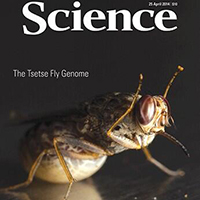 Successfully decoding the tsetse fly’s genetic sequence could have a massive impact, and was the latest edition of Science magazine’s cover story
Successfully decoding the tsetse fly’s genetic sequence could have a massive impact, and was the latest edition of Science magazine’s cover story
Scientists at the University of Liverpool have been part of a ten-year project which has successfully sequenced the genetic code of the tsetse fly – making major advances in disease control possible.
Tsetse flies are unique to Africa and can infect people bitten by them with sleeping sickness, a disease which damages the nervous system and is fatal if untreated. This kills over 250,000 people each year.
Traditional methods of control such as releasing sterile males, trapping and pesticide spraying are expensive and difficult to implement. Sleeping sickness can also evade the immune system, making a vaccine hard to create, so the genetic information will allow researchers to develop alternative strategies to control the disease.
Alternative strategies
Geneticist, Professor Neil Hall is one of the project leaders. He said: “Essentially we have decoded and annotated the the genetic sequence which makes up the tsetse fly. We are now able to identify the genes which control some of its unique physiology including breeding and diet.
“This paves the way for further research into destroying or controlling the flies before they infect human populations in Africa.”
Tsetse flies are a unique species in many aspects of their behaviour. They only feed on the blood of vertebrates and they also give birth to live young, rather than laying eggs, and feed these young with a substance which is chemically similar to milk.
Almost 140 scientists have worked on sequencing and annotating of the Tsetse fly – Glossina morsitans. Professor Hall alongside colleagues Dr Christiane Hertz-Fowler and Dr Alistair Darby at the University’s Centre for Genomic Research were involved in the project set-up and design, as well as much of the analysis.
Initial automated mapping of the genome was examined in more detail by specialist researchers to closely identify genes involved in topics such as smell, taste, vision, reproduction, digestion, blood feeding, immunity, metabolism and stress response.
All of the findings from the project – called the International Glossina Genome Initiative – have been uploaded to a free genomic database on the tsetse fly, so that scientists around the world can use them for research. The project is ongoing and more information will be added over time.
New possibilities
Professor Hall concluded: “Decoding this genome has been a long and painstaking process, but now that the data is available to researchers, a range of possibilities for controlling sleeping sickness have opened up.”
The paper, Genome Sequence of the Tsetse Fly (Glossina morsitans): Vector of African Trypanosomiasis, was published in Science.
The research was funded by the Wellcome Trust, World Health Organisation and the Ambrose Monell Foundation. The lead institutions on the project were the University of Tokyo, Yale University, the Liverpool School of Tropical Medicine, CIRAD, the Wellcome Trust Sanger Institute the University of the Western Cape and the University of Liverpool.
Follow the Centre for Genomic Research on Twitter or find out more about taking a degree in the subject on the University’s Study pages.
